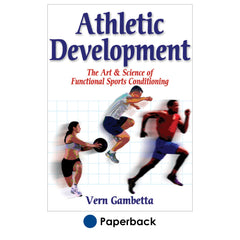Defining supercompensation training
This is an excerpt from Athletic Development by Vern Gambetta.
The body is always seeking to maintain a state of homeostasis so it will constantly adapt to the stress from its environment. Training is simply the manipulation of the application of stress and the body's subsequent adaptation to that stress to maintain homeostasis. The adaptation that occurs is fairly predictable. In training the desired adaptive response is called supercompensation.
The supercompensation model is still the most straightforward representation of the training process. I use it as a conceptual basis for the construction of my training sessions and microcycles as well as construction of mesocycles. The process is predictable and quantifiable once you have developed your training system.
Supercompensation is a four-step process. The first step is the application of a training or loading stress and the body's subsequent reaction to this training stress, which is fatigue or tiring. There is a predictable drop-off in performance because of that stress. Step 2 is the recovery phase. This can be a lighter training session, a recovery session, or active rest. As a result of the recovery period, the energy stores and performance will return to the baseline (state of homeostasis) represented by the point of the application of the original training stress. Step 3 is the supercompensation phase. This is the adaptive rebound above the baseline; it is described as a rebound response because the body is essentially rebounding from the low point of greatest fatigue. This supercompensation effect is not only a physiological response but also a psychological and technical response. The last step in the process is the loss of the supercompensation effect. This decline is a natural result of the application of a new training stress, which should occur at the peak of supercompensation. If no training stress is applied, there will also be a decline. This is the so-called detraining phenomenon.
Different physical qualities respond at different rates, so it is misleading to think that there's one generalized supercompensation curve. Essentially each physical quality has its own individual supercompensation curve. These differences in timing for supercompensation are due to the duration of the various biological regeneration processes that take place during the recovery phase. The replenishment of creatine phosphate will take only a few seconds to a couple of minutes to return to normal levels, but the glycogen-reloading process in the muscle may last 24 hours; in some cases, it may last even longer. The production of new enzymes (proteins) may also take hours, sometimes even days, to complete (Olbrecht 2000). The art is designing these curves of adaptation so that they coincide at the proper time. Working out the timing of the various components is possibly the most difficult aspect of planning. It is as much an art as it is a science. The best way to perfect this is with practice.
In supercompensation the athlete can handle the same training load or a greater load with ease in the subsequent workouts if recovery is adequate and the new stress is timed properly. This adaptive phenomenon is an ongoing wavelike process. If all the variables are manipulated correctly and the proper ratio of work to recovery is achieved, the result is a continually rising sinusoidal curve pointed toward higher-level performance.
To ensure supercompensation, the athlete must be healthy. The training volume, intensity, and frequency must be appropriate for the particular athlete. If training is too intense, the athlete will struggle to get back to baseline, and no supercompensation will occur. If training is too easy, there will be very little adaptive response. If extremely easy training is continued over several training cycles, then the principle of reversibility will take effect. Simply stated, the principle of reversibility is “use it or lose it.” If the training load is adequate and the timing of the application of the training stress is correct, then a supercompensation effect will occur.
There is another theory regarding the process of adaptation to the stress of training; it is called the two-factor, or fitness fatigue, theory. “According to the two-factor theory of training, the time intervals between consecutive training sessions should be selected so that all the negative traces of the preceding workout pass out of existence but the positive fitness gain persists” (Zatsiorsky 1995,
p. 15). The premise is that the fitness effect of training is slow changing and long lasting while the fatigue effect of training is of shorter duration but of greater magnitude. The two factors, fitness and fatigue, are the immediate training effects of every workout. The most immediate effect of any workout is fatigue, but the long-term effect is the adaptive changes in the targeted motor qualities over time.
The two-factor model has been proposed as a more sophisticated model. I do not think this is the case; rather, it is a logical extension of the supercompensation model. I think that both models are complementary and further explain the process of adaptation to the stress of training. The key to applying the models is understanding that different motor qualities and physical capacities adapt at different rates. In planning training, I use a blend of both models with a slight bias toward supercompensation because that is the model I started with and it has always worked well for me.
This is an excerpt from Athletic Development.


Get the latest insights with regular newsletters, plus periodic product information and special insider offers.
JOIN NOW


